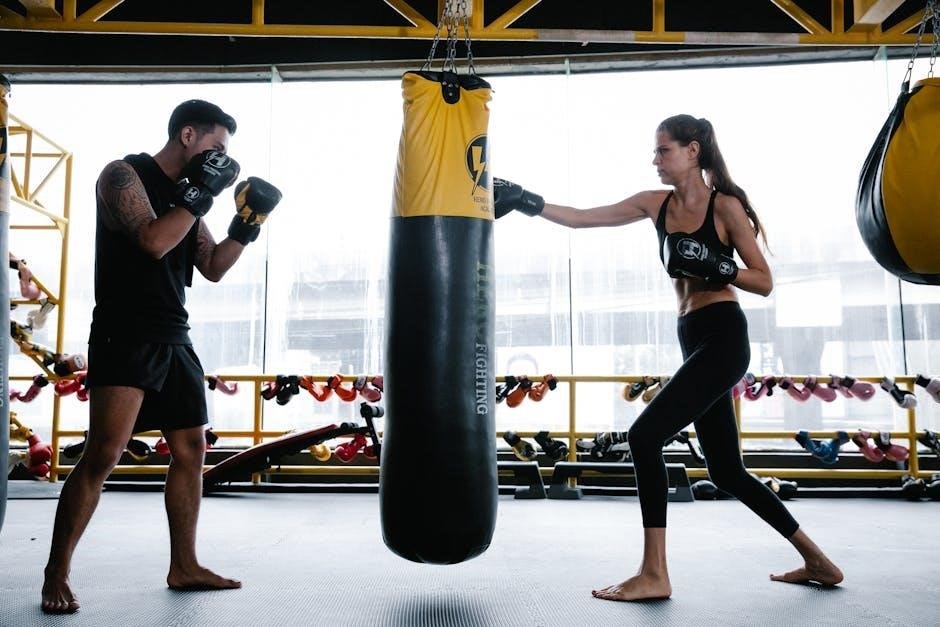Boxing Glove Sizes Guide
Selecting the right boxing glove size is crucial for optimal performance and safety․ This guide offers comprehensive charts and information to help you choose the perfect fit based on your weight‚ hand size‚ and training needs․ Explore our guide to find the ideal gloves for boxing․

Choosing the right boxing glove size is paramount for both safety and performance in boxing and related martial arts․ Boxing gloves are not a one-size-fits-all item; they come in various sizes‚ typically measured in ounces (oz)‚ to accommodate different hand sizes‚ body weights‚ and training purposes․ Understanding the nuances of glove sizing is crucial for beginners and experienced fighters alike․
This comprehensive guide delves into the intricacies of boxing glove sizes‚ providing you with the knowledge to make an informed decision․ We’ll explore how glove size relates to your weight class‚ hand measurements‚ and the type of training you’ll be undertaking‚ whether it’s bag work‚ sparring‚ or professional fighting․ A properly fitted glove not only enhances comfort but also provides essential protection for your hands and wrists‚ reducing the risk of injury․
Furthermore‚ we’ll examine the materials used in glove construction and their impact on fit and feel․ By the end of this guide‚ you’ll be equipped with the tools to navigate boxing glove size charts‚ understand common FAQs‚ and select the perfect pair of gloves to meet your specific needs and skill level․ This ensures a safer and more effective training experience․
Boxing Glove Size Chart by Weight Class
Selecting the correct boxing glove size often correlates with an individual’s weight and height․ While hand size is a critical factor‚ weight class provides a general guideline for choosing the appropriate glove weight․ This correlation ensures that the glove offers adequate protection and cushioning relative to the force of impact․
For individuals under 100lbs‚ commonly children‚ 8-10 oz gloves are typically recommended․ Women‚ generally between 100lbs-125lbs‚ often find 10-12 oz gloves suitable․ As weight increases‚ so does the recommended glove size․ Individuals between 125lbs-150lbs may opt for 12-14 oz gloves‚ while those between 150lbs-180lbs often use 14-16 oz gloves․ Boxers over 180lbs usually prefer 16 oz gloves for training and sparring․
This weight-based chart serves as a starting point‚ but it’s essential to consider individual hand size and the intended use of the gloves․ For bag work‚ lighter gloves may be preferred‚ while sparring typically requires heavier gloves for increased protection․ Always prioritize safety and comfort when choosing your boxing glove size‚ and consult with a trainer for personalized recommendations tailored to your specific needs and training regimen․
Glove Sizes for Different Body Weights

Choosing the right boxing glove size based on body weight is crucial for safety and effective training․ Generally‚ lighter individuals use lighter gloves‚ while heavier individuals require heavier gloves to provide adequate protection for both themselves and their sparring partners․ Understanding this correlation is essential for selecting the correct glove weight․
For boxers weighing under 100 lbs‚ typically children‚ 8-10 oz gloves are commonly used; Those between 100-125 lbs often opt for 10-12 oz gloves‚ which are frequently suitable for women․ As weight increases to 125-150 lbs‚ 12-14 oz gloves become a more appropriate choice․ Boxers weighing 150-180 lbs generally use 14-16 oz gloves‚ providing a balance of protection and maneuverability․
For individuals over 180 lbs‚ 16 oz gloves are typically recommended‚ offering maximum padding for sparring and heavy bag work․ However‚ it’s important to note that these are general guidelines․ Factors like hand size‚ training intensity‚ and personal preference also play a significant role in determining the ideal glove size․ Always prioritize safety and comfort when making your selection‚ and consult with a boxing coach or experienced trainer for personalized advice tailored to your specific needs․
Understanding Ounce (oz) Weight in Gloves
The weight of boxing gloves‚ measured in ounces (oz)‚ is a critical factor influencing their purpose and suitability for different training activities․ The ounce weight refers to the padding inside the glove‚ directly impacting the level of protection offered to both the wearer and their sparring partner․ Understanding the significance of ounce weight is essential for making informed decisions․
Lighter gloves‚ typically ranging from 8 oz to 12 oz‚ are often used for bag work‚ mitt work‚ and lighter sparring sessions․ These gloves allow for greater speed and agility‚ enhancing technique development․ Heavier gloves‚ ranging from 14 oz to 16 oz or even higher‚ are primarily designed for sparring and training․ The increased padding in heavier gloves provides superior shock absorption‚ minimizing the risk of injury during intense sessions․
For professional fights‚ glove weight is often regulated based on the weight class of the boxers․ Lighter weight classes typically use 8 oz or 10 oz gloves‚ while heavier weight classes may use 10 oz or 12 oz gloves․ The choice of glove weight depends on the purpose‚ level of protection required‚ and regulations of the specific boxing event․ Selecting the appropriate ounce weight is crucial for maximizing performance and minimizing the risk of injury․
Glove Sizes for Training vs․ Sparring vs․ Professional Fighting
Choosing the right boxing glove size is essential‚ but the type of activity—training‚ sparring‚ or professional fighting—significantly influences this choice․ For general training‚ such as hitting the heavy bag or working with focus mitts‚ gloves ranging from 12 oz to 14 oz are commonly recommended․ These gloves offer a balance between protection for your hands and wrists and the ability to maintain speed and technique․
Sparring requires more padding to protect both you and your partner․ Gloves weighing 16 oz are generally preferred for sparring‚ providing ample cushioning to reduce the impact of punches․ Some boxers may even opt for larger‚ 18 oz gloves for added safety during intense sparring sessions․ The extra padding minimizes the risk of cuts‚ bruises‚ and more serious injuries․
Professional fighting often involves specific regulations regarding glove weight‚ typically ranging from 8 oz to 10 oz‚ depending on the weight class; These lighter gloves allow for faster punches and greater impact‚ but offer less protection compared to training or sparring gloves․ Boxers in professional fights must adhere to these regulations‚ prioritizing speed and power while accepting a higher risk of injury․
Measuring Your Hand for Glove Size
Accurately measuring your hand is critical for selecting boxing gloves that fit comfortably and provide adequate protection․ Start by using a flexible measuring tape to determine the circumference of your dominant hand‚ wrapping it around the widest part of your palm‚ just below the knuckles․ Make a fist while measuring to ensure an accurate reading‚ but don’t clench it too tightly․
Next‚ measure the length of your hand from the base of your palm to the tip of your longest finger․ These two measurements‚ circumference and length‚ will serve as your primary reference points when consulting boxing glove size charts․ Glove manufacturers typically provide size charts that correlate hand measurements with specific glove sizes‚ often expressed in inches or centimeters․
Keep in mind that hand size can vary even among individuals of similar body weight․ Therefore‚ relying solely on weight-based recommendations may not always yield the best fit․ Always refer to the manufacturer’s size chart and compare your hand measurements to ensure you select the appropriate glove size․ A well-fitted glove should feel snug but not overly tight‚ allowing for comfortable hand movement and proper fist formation․

Boxing Glove Size Chart for Men and Women
While boxing glove sizes are often presented in a unisex format based on weight‚ it’s helpful to understand nuances that may cater to typical differences in hand size and structure between men and women․ Generally‚ women may find that gloves designed with a narrower hand compartment offer a more secure and comfortable fit․ However‚ this isn’t a hard rule‚ and individual hand size should always be the primary factor․
Size charts typically correlate glove weight (in ounces) with body weight․ For instance‚ a person weighing between 125lbs and 150lbs might opt for 12-14 oz gloves․ However‚ women with smaller hands might find a 12 oz glove fits better‚ while men with larger hands might prefer the 14 oz option․
It’s crucial to consult specific size charts provided by glove manufacturers‚ as sizing can vary slightly between brands․ When in doubt‚ it’s often recommended to try on gloves in person or order a range of sizes to determine the best fit․ Remember that hand wraps are always worn inside boxing gloves‚ so factor this into your sizing considerations․ A snug fit with wraps is ideal for optimal protection and performance․
Kids Boxing Glove Sizes
Selecting the right boxing gloves for kids is paramount for their safety and enjoyment of the sport․ Unlike adult sizes‚ children’s gloves are often categorized by age and weight‚ acknowledging the rapid growth and varying hand sizes within this demographic․ Common sizes include 4 oz‚ 6 oz‚ and 8 oz‚ generally suitable for children aged 5-12 years old․ However‚ this is a guideline‚ and individual hand measurements are crucial for accurate fitting․
Younger children typically start with 4 oz or 6 oz gloves‚ providing adequate padding without being too bulky or heavy․ As they grow and gain weight‚ they can transition to 8 oz gloves‚ which offer more protection for both the child and their sparring partners․ When choosing gloves‚ consider the type of training the child will be doing․ For bag work‚ lighter gloves may suffice‚ but for sparring‚ heavier‚ more padded gloves are essential․
Always prioritize a snug but comfortable fit․ Gloves that are too loose can lead to injuries‚ while gloves that are too tight can restrict movement and cause discomfort․ Encourage kids to try on gloves with hand wraps‚ as these add extra padding and ensure a secure fit․ Parental supervision and guidance are key to selecting the right size and ensuring proper usage‚ fostering a positive and safe boxing experience for young athletes․

Materials and Their Impact on Glove Size and Fit
The materials used in boxing glove construction significantly influence their size‚ fit‚ and overall performance․ Leather and synthetic leather are the primary choices‚ each offering distinct characteristics․ Leather gloves‚ prized for their durability and breathability‚ often mold to the wearer’s hand over time‚ providing a more customized fit․ However‚ leather can stretch slightly‚ affecting the glove’s initial snugness․
Synthetic leather‚ such as vinyl or PU (polyurethane)‚ offers a more consistent size and shape‚ as it is less prone to stretching․ These materials are also typically more affordable and easier to maintain․ However‚ synthetic gloves may not breathe as well as leather‚ potentially leading to increased moisture buildup during intense training sessions․
The padding material also plays a crucial role․ Foam padding‚ whether layered or injected‚ determines the glove’s overall bulk and protection level․ Softer foams may compress more‚ impacting the fit over time‚ while denser foams offer more consistent cushioning but can feel stiffer initially․ The lining inside the glove‚ often made of moisture-wicking fabrics‚ contributes to comfort and can affect how the glove slides on and off․ Ultimately‚ the combination of these materials dictates the glove’s size‚ shape‚ and long-term fit‚ making material selection a key consideration when choosing boxing gloves․
Boxing Glove Size Chart ⏤ Common FAQs and Tips for Beginners
Navigating the world of boxing glove sizes can be daunting for beginners․ A common question is‚ “How do I choose the right size?” The general rule of thumb is to correlate glove weight (measured in ounces) with your body weight․ Lighter individuals typically use lighter gloves‚ while heavier individuals require heavier gloves for adequate protection․ However‚ hand size also plays a crucial role․
Another frequent query concerns the difference between training and sparring gloves․ Training gloves often range from 12 to 16 ounces‚ offering versatility for bag work and pad drills․ Sparring gloves‚ typically 16 ounces or heavier‚ provide extra padding to protect both the wearer and their sparring partner․ It’s essential to prioritize safety during sparring sessions․
A key tip for beginners is to try on gloves whenever possible․ If purchasing online‚ carefully review size charts and consider reading customer reviews for insights on fit․ Remember to wrap your hands before trying on gloves‚ as hand wraps add bulk and affect the overall fit․ Don’t hesitate to seek advice from experienced trainers or boxing equipment specialists to ensure you select the most appropriate glove size and type for your individual needs and training goals․
